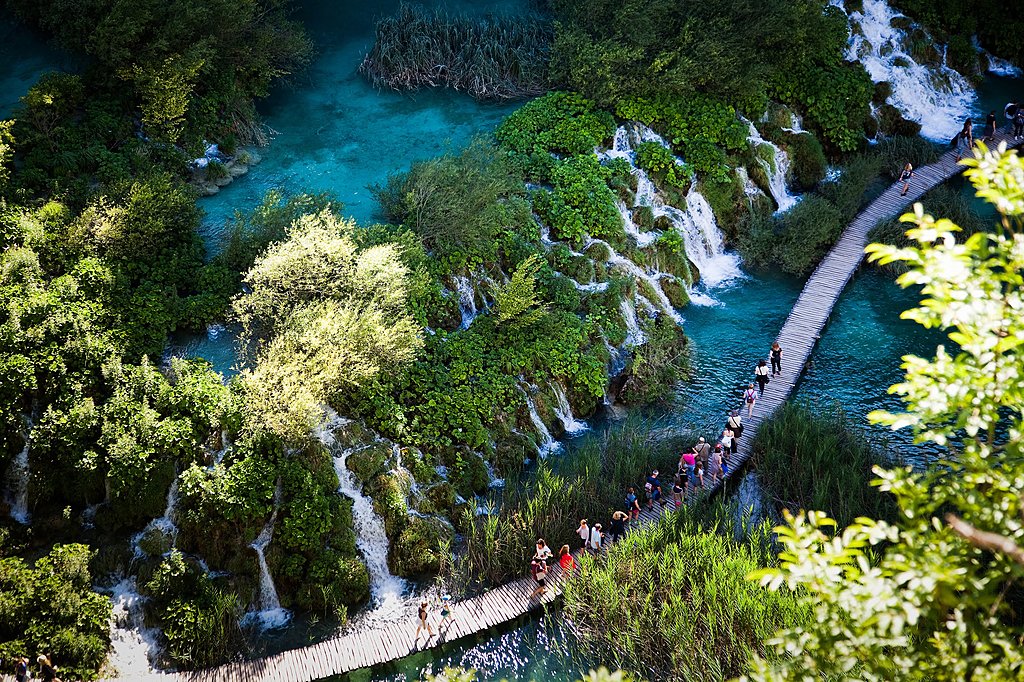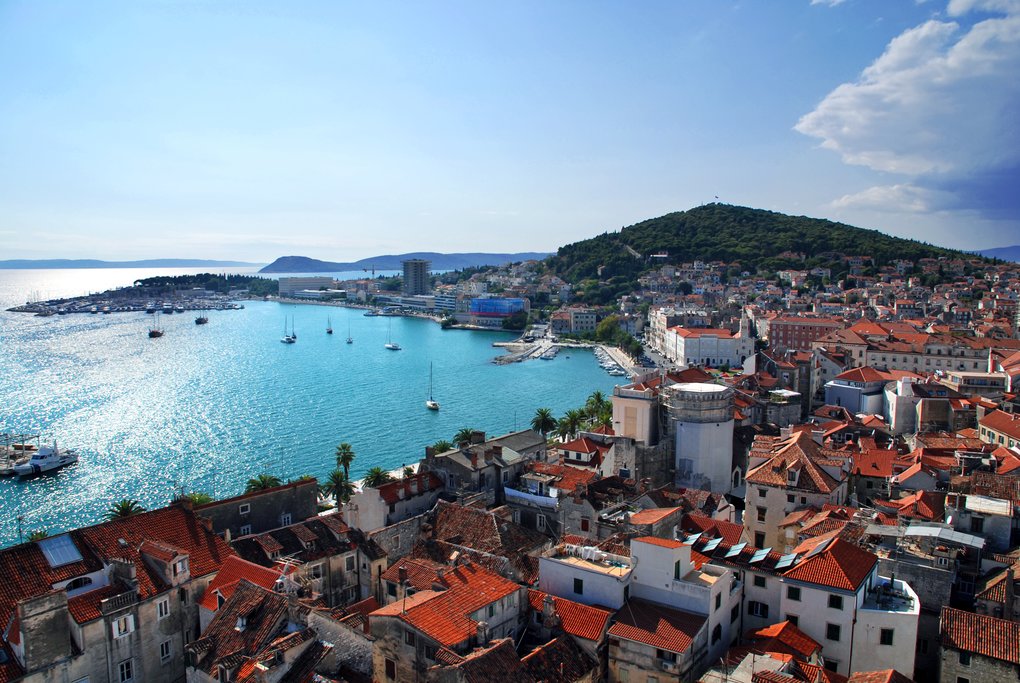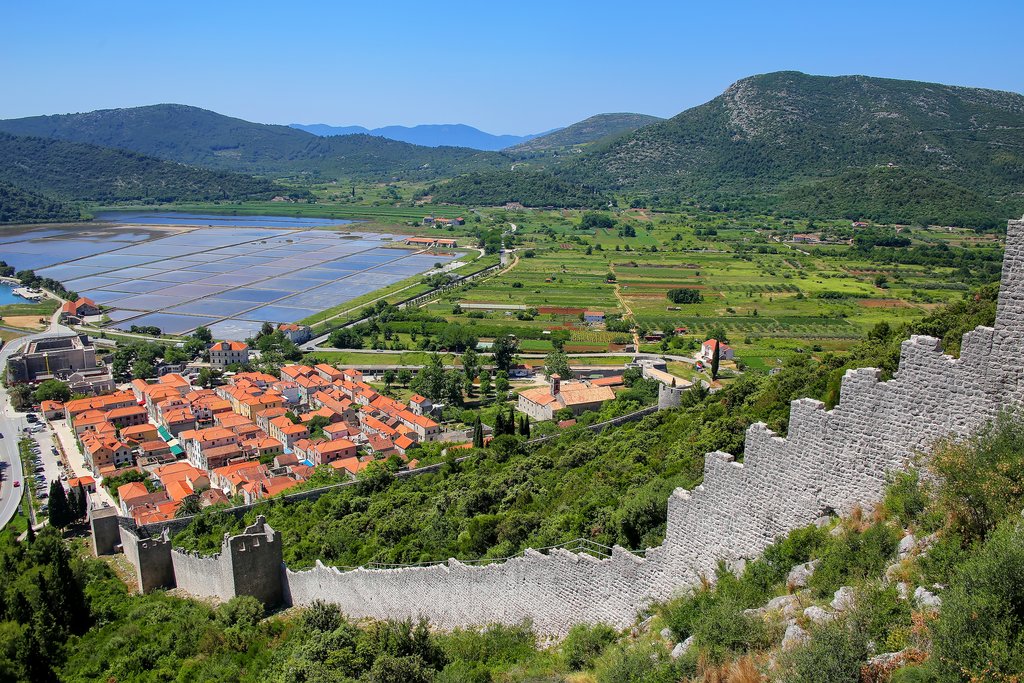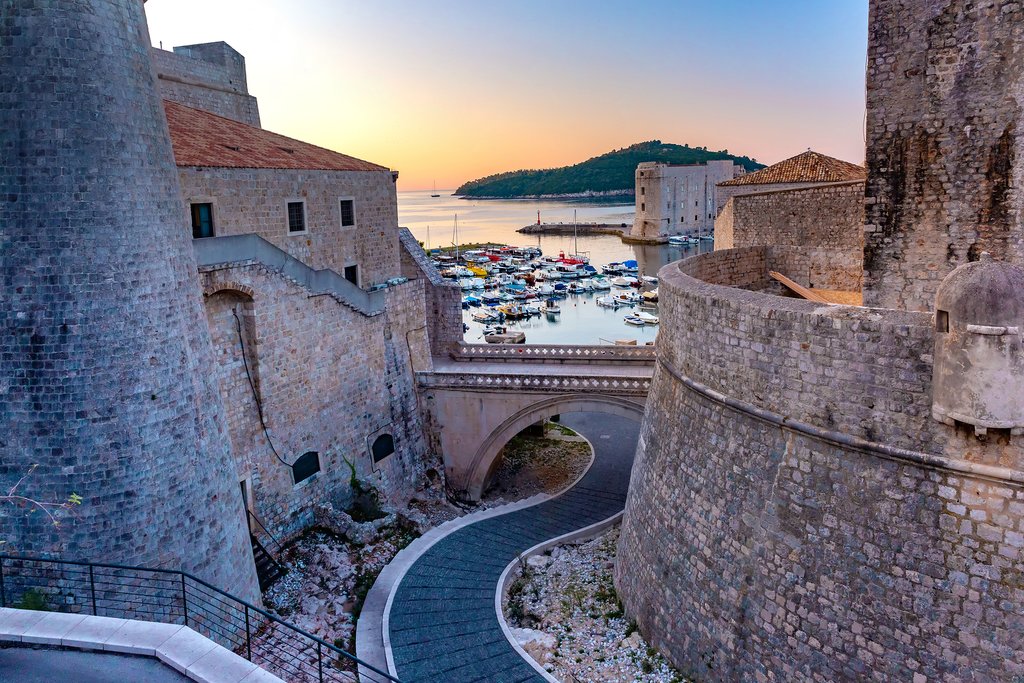Highlights
- Discover the fairytale forest & castles of Zagorje
- Hike through waterfalls & river islands at Plitvice Lakes & Krka National Park
- Stroll the ancient halls of Diocletian's Palace in Split
- Set sail to the Dalmatian islands of Brač, Hvar & Korcula
- Cycle & sip your way through the rugged wine country of Pelješac
- Get lost in the history of Dubrovnik's famed Old Town
Brief Itinerary
| Day | Highlights | Overnight |
|---|---|---|
| Day 1 | Arrive in Zagreb | Zagreb |
| Day 2 | Scenic Castles of the Zagorje Region | Zagreb |
| Day 3 | Zagreb City Tour - Plitvice Lakes | Plitvice Lakes |
| Day 4 | Hike Plitvice Lakes National Park - Skradin | Skradin |
| Day 5 | Krka National Park - Trogir | Trogir |
| Day 6 | Explore Split - Sail to Brač | Milna |
| Day 7 | Sailing Day, Brač to Hvar | Hvar |
| Day 8 | Sailing Day, Hvar to Korčula | Korčula Island |
| Day 9 | Explore Korčula Island | Korčula Island |
| Day 10 | Pelješac Penisula & Ston | Ston |
| Day 11 | Lopud & Koločep Islands - Dubrovnik | Dubrovnik |
| Day 12 | Explore Dubrovnik | Dubrovnik |
| Day 13 | Depart Dubrovnik |
Detailed Itinerary
Day 1: Arrive in Zagreb

Start your adventure from Zagreb, the capital of Croatia. Upon arrival at the airport, you'll transfer to your hotel to settle in where you'll have the rest of the day to spend as you like. The city center is easily walkable and the streets and parks are easy to navigate on foot. All the main attractions and restaurants are within walking distance.
A gem of a European city, Zagreb is at once historic and new. It's filled with leafy green parks and Gothic/neo-Renaissance buildings, yet there are also modern shopping complexes, outdoor malls, and endless dining and drinking options. Consider heading out on a guided walking tour of the historic heart of the city. This involves walking from Ban Jelačić, the main square, to Zagreb's Upper Town and passing through local markets before reaching St. Mark's Square.
Alternatively, you can visit one of the many museums and art galleries, like the Homeland War Museum, the Nikola Tesla Technical Museum, or the ever-popular Museum of Broken Relationships. Or stroll through the city center, enjoying 17th-century neo-baroque architecture found at Zagreb's Art Pavilion and Croatian National Theater. Zagreb also has several beautiful city parks which are great for exploring and people-watching, especially in the late afternoon.
Day 2: Scenic Castles of the Zagorje Region

Just a few miles northwest of Zagreb lies Zagorje, a bucolic hilly region, dotted with Renaissance and medieval fortresses, numerous baroque castles, and family-run vineyards and farms. It's a memorable, romantic landscape that will take you back in time to a sense of both the aristocratic past and the rural traditional way of life that still exists in Croatia today. A quick day trip from Zagreb allows you to immerse yourself in this beautiful region.
Find your way to Trakošćan Castle, a good example of one of these storybook locales, as it sits perched on a hill adjacent to a glassy lake. The castle, a historic landmark, was built in the 14th century as a defensive fortress but was later used as a home for aristocratic Croatian families. On a tour, you can not only visit the castle grounds but you'll go inside and explore all four floors, which function as a museum with permanent exhibitions.
Afterward, visit Veliki Tabor Castle, which is located just southwest of Trakošćan. This Gothic-Renaissance castle dates to the 16th century and also sits on a green hill overlooking the fertile countryside. It was originally built for a noble Hungarian family and its fortifications were designed to defend against Turkish invaders. A tour of Veliki includes visits to the towers, guardhouses, and inner courtyard plus a small museum featuring exhibitions of medieval artifacts like armor, weapons, and paintings.
Apart from castles, explore nearby old villages, like Kumrovec, where you'll find restored peasants' houses from the 19th century. These are great areas to browse local craft shops and enjoy some traditional country cuisine like grilled lamb, meat skewers, and veal stuffed with cheese and ham. Kumrovec is most well known for being the birthplace of Marshal Josip Broz Tito, the communist revolutionary who was President of Yugoslavia from 1953 to 1980.
After a day of exploring, return to Zagreb for the evening.
Day 3: Zagreb City Tour - Plitvice Lakes

This morning is yours to explore Zagreb at your own pace. Head to Ban Jelačić Square at the heart of the city and wander the bustling open-air markets—a bounty of local produce, flowers, jams, and honey. There's also an entire area of vendors selling an array of handcrafted cheeses, cured meats, pastries, and other locally-made products.
Opt for a guided walking tour that will take you through the history of the city, sharing the stories, legends, and pivotal events of its past. You will learn about the history of Zagreb since the Middle Ages as you traipse the cobblestone streets of Gornji Grad and over to the Cathedral and Kaptol, the religious core.
After lunch, it's time to bid Zagreb farewell and drive south to the Plitvice Lakes, where you'll spend the night. Along the way, you'll pass many scenic stops, such as Rastoke—a small village located where the Slunjčica and Korana rivers converge.
Day 4: Hike Plitvice Lakes National Park - Skradin

Start today by exploring one of Croatia’s most popular national parks, Plitvice Lakes.
Plitvice Lakes National Park is Croatia’s natural masterpiece, gorgeous at any time of year. A must-visit for any traveler to Croatia, the UNESCO-protected park is comprised of an exquisite collection of 16 glassy emerald green and blue travertine lakes, more than 90 cascading waterfalls that seemingly cover every corner of the park, and numerous caves. The terraced lakes are surrounded by beech and pine forests and are home to extensive wildlife.
After Plitvice, drive to the Dalmatia region to overnight in the beautiful village of Skradin. This charming small town with a long history is situated on the river banks of the Krka River and next to a charming small marina and the entrance to the famed Krka National Park. Feel free to walk around on your own before dinner and take a short hike to the small fortress above the town.
Day 5: Krka National Park - Trogir

Start today with a visit to nearby Krka National Park, home to a network of striking waterfalls, including the largest and showiest known as Skradinski Buk. The Krka River, another highlight of the park, carves through the limestone and creates a spectacular canyon on its 44-mile (70 km) journey from the foothills of the Dinaric Alps to Šibenik.
You'll traverse emerald pools and river islands to reach prime lookout spots to view the falls. Skradinski Buk is the final of the seven waterfalls, and Mother Nature saved the best for last. Cascading 149 feet (45 m) down into an emerald lagoon wider than the falls are tall, you'll find restaurants, snack stands, and ice cream shops at the base of this postcard locale to satisfy any food-related cravings, perfect for lunch.
After Krka, you'll get back on the road and continue your journey south to Trogir. At more than 2,000 years old, Trogir is one of Croatia's Unesco World Heritage Sites and a great example of a beautiful island fortress town. It's a small place, and it doesn't take longer than about five minutes to walk from any point in Trogir's historic center to reach the sea.
Your afternoon is free to explore. Stroll the narrow cobbled streets, enjoy the romanesque architecture and medieval stone walls, and don't be surprised if you hear the harmonies of Trogir's famous Dalmatian Accapella singers carrying through the air. For Instagram-worthy photos, head to Kamerlengo Castle, a fortress built by the Venetians in the 15th century. From atop its battlements, you'll have incredible panoramic views of Trogir and the surrounding area.
Chat with a local specialist who can help organize your trip.
Day 6: Explore Split - Sail to Brač

In the morning you'll continue down the coast to reach the historic port city of Split. Travelers come from far and wide to walk along Split's Riviera-esque waterfront and tour the impressive Diocletian’s Palace, located in the heart of Split's historic center. This "city within a city" is a maze of narrow alleyways within stone fortifications originally built for Emperor Diocletian back at the turn of the fourth century CE.
The palace has changed its appearance over the centuries as a medieval city grew up around it, but it's still one of the best-preserved examples of Roman architecture in Croatia. In point of fact, it's a UNESCO World Heritage Site. There's nothing quite like strolling the narrow stone streets inside the palace fortifications and ducking into little cafés/bakeries/bars for a cinnamon roll, ice cream cone, or a glass of wine. You can enjoy the city on your own or stroll the streets on a guided tour of the city. A tour is ideal as the guide will be able to point out all the hidden gems within the walls of Diocletian’s Palace.
In the afternoon, make your way to the marina, where you'll be greeted by your skipper and set sail towards the island of Brač. The largest of the central Dalmatian Islands, Brač is bursting with historic sites dating back to ancient Greece and the Middle Ages. Brač is also famous for its stone sculptures and quarries, where its stone was used in the construction of Split's Diocletian's Palace and the White House in Washington, D.C. Moor in the sheltered harbor of Milna, then stretch your legs and soak up the island's evening atmosphere as you stroll along seafront promenades finding your way to a harborside bar or restaurant.
Day 7: Sailing Day, Brač to Hvar

Today you'll continue your sailing journey to the island of Hvar, renowned for its natural setting, mild climate, and historic town of the same name. You'll have the rest of the morning to explore Hvar Town, where you can visit the Renaissance-era Cathedral of St. Stephen or climb the steps to the terrace outside of the historic Arsenal to enjoy views over the harbor and the surrounding area.
For some of the best views of the island, Hvar Town, and the nearby Pakleni Islands, take a short walk up to the 16th-century Španjola Fortress. After the day's adventures, treat yourself to a drink in the ancient piazza of Hvar overlooking the Venetian loggia, 7th-century fortification walls, and the oldest municipal theater in Europe.
Day 8: Sailing Day, Hvar to Korčula

Disembark at Korčula today for a full day of exploration as you roam the maze of gray stone houses, alleys, churches, and squares.
Enjoy a traditional lunch of lamb and goat in Korčula's Old Town, one of the finest examples of Venetian architecture on the Dalmatian coast. Next, visit the 14th-century Land Gate on top of an elegant staircase, before heading to St. Mark's Cathedral to admire its strange sculptures of beasts and people. Art enthusiasts will appreciate a visit to the Bishop's Treasury next door for a small but impressive art collection, including works from Carpaccio, Bassano, and Tiepolo. From there, you may wish to visit the unassuming local house thought to be the birthplace of Marco Polo.
Day 9: Explore Korčula Island

This morning, say goodbye to your boat and skipper and set out to explore the rest of Korčula's many highlights at your leisure.
The island itself is 107 square miles (172 km) and consists of a gorgeous mix of beaches, vineyards, villages, and quiet, harbor-side restaurants and resorts. For a pleasant and scenic way to cover the most ground, rent a bike or scooter and find your way to a secluded beach or hidden cove. Ride through fields, villages, and wineries, covering asphalt, gravel, and dirt roads with vistas opening up to the Adriatic Sea as well as to the impressive Mt. Ilija on the nearby Pelješac Peninsula.
This gentle route explores the ancient and historical sites of the eastern side of the island as you work your way to the spread-out village of Lumbarda. Boasting beautiful beaches and centuries-old winemaking traditions, Lumbarda is home to Grk, a white wine grape variety that will pair well with your lunch or dinner. Some of Croatia's best white wines are produced on Korčula and you won't be left wanting.
Day 10: Pelješac Penisula & Ston

Today you will leave Korčula and head back to the mainland to discover the rugged Pelješac Peninsula. A mountainous finger of land reaching into the Adriatic Sea, the Pelješac region is home to Croatia's finest red wines, tastiest oysters, and some of the best sand and shingle beaches in the country. Your base for the night is Ston, a peaceful little town with lots of history and a great culinary reputation.
Explore the countryside with a cycling trip through lush vineyards overlooking the sea, working up an appetite for some local fare in time for lunch. In the afternoon (depending on weather conditions), see the peninsula from a different vantage point with a sea kayaking excursion. You can set off either from the south side of the peninsula in a small village with many hidden beaches, or from Ston Bay, famous for growing oysters and mussels since Roman times.
Later in the afternoon, head back to dry land for a hike along the city's famous medieval walls. Built to keep invaders away from the area's precious saltpans, the 14th-century marvel is the longest fortified city wall on the continent. The preserved section for walking is less than 2 miles (3.2 km) and rewards hikers with breathtaking vistas as you climb, ending at Ston's tiny idyllic neighbor of Mali Ston.
Day 11: Lopud & Koločep Islands - Dubrovnik

Continue southward today to the Dubrovnik archipelago, where you can choose to visit one of two nearby islands for a day of sand, sea, and hiking.
The first, Lopud, lies just west of Dubrovnik and Koločep. During Dubrovnik's prime, Lopud once functioned as a weekend retreat for Dubrovnik’s nobility and was home to many of the city's merchant fleet—ruins of the many shipowner homes still occupy the corners of Lopud's only village of the same name. Covering an area of nearly two square miles (4.6 square km), Lopud is the most economically developed of the Elafiti Islands and is home to the region's largest sandy beach, Šunj. Here you can wade into the shallow water for 300 feet (91 m) before the need to swim takes over.
For the more active traveler, there are several hiking trails to choose between that lead you among Mediterranean and subtropical vegetation, though you might like to trek the 6-mile (10 km) loop around the larger part of the island. You will be rewarded with some of the island's best attractions, including a visit to the Sutvrac fortress where you will have stunning panoramic views of nearby Šipan and the Pelješac Peninsula to the north.
The second option is a trip to Koločep, the southernmost inhabited island in Croatia. Just 20 minutes from Dubrovnik and with approximately 100 year-round inhabitants, the sleepy and car-free Koločep is an ideal destination for walking/hiking, sea kayaking, or just relaxing and enjoying its famed sandy beaches. Go for a guided walk around the island, and stop in at one of its small family-run restaurants for some of the best-grilled calamari in Croatia.
In the afternoon, make your way to your accommodation in the historic coastal fortress city of Dubrovnik. The remainder of the evening is at your leisure, allowing time for you to wander and explore this magical city. Climb the 16th-century city walls for incredible views of countless red rooftops of old stone houses, towers, turrets, churches, and palaces. And be sure to find your way to the limestone-paved Stradun, Dubrovnik's main street to get your bearings and choose from some of Croatia's best restaurants and wine bars.
Day 12: Explore Dubrovnik

Today is all about Dubrovnik! Known as the "Pearl of the Adriatic," Dubrovnik is a world-renowned city of exceptional charm. Throughout the middle ages, it was a fortress port encircled by stone walls and filled with baroque churches and Renaissance/Gothic palaces that still stand today.
There's no better way to pass the time in Dubrovnik than to spend an afternoon strolling its historic walls and smooth, limestone-paved streets while marveling at the spirit of the city. Can't-miss activities include riding the cable car up to Srđ Mountain to take in the sunset over the nearby Elafiti Islands and visiting the Lovrijenac fortress. A tour with a local guide will be that much more rewarding, as they will lead you to the best spots and offer insight into Dubrovnik's culture and history.
Day 13: Depart Dubrovnik

Bid Croatia farewell as you transfer to the airport today to catch your flight home. Safe travels!
